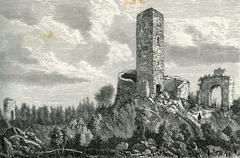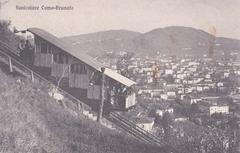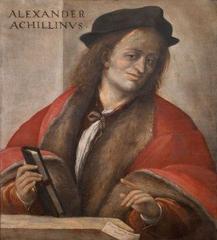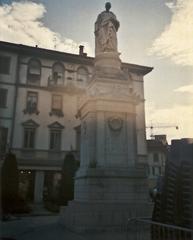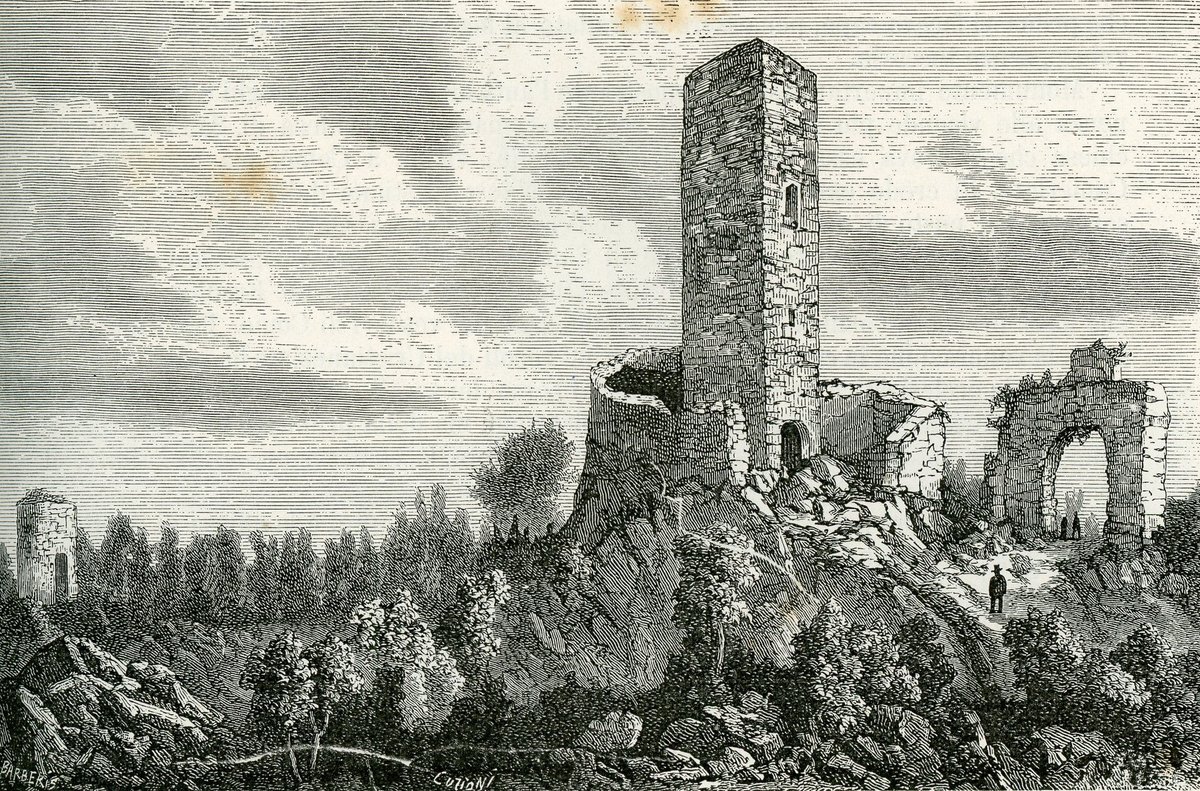
Castello Baradello: Visiting Hours, Tickets, and Guide to Como’s Most Iconic Historical Site
Date: 15/06/2025
Introduction
Rising above the city of Como atop Monte Baradello, Castello Baradello is a commanding presence that offers not only panoramic views of Lake Como and the Alps but also a window into northern Italy’s rich and tumultuous history. This medieval fortress, with origins stretching back to the 1st millennium BC, has served as a strategic stronghold, imperial bastion, and symbol of local heritage. Today, it remains a must-visit destination for travelers seeking a blend of culture, nature, and history in the heart of the Parco Regionale Spina Verde (SpottingHistory; Como and Its Lake; Comune di Como; Visit Como).
This guide provides detailed information on visiting hours, ticketing, accessibility, and notable nearby attractions, alongside an exploration of the castle’s enduring cultural and architectural legacy.
Table of Contents
- Introduction
- Ancient Origins and Early Fortifications
- Medieval Reconstruction and the Era of Frederick Barbarossa
- Power Struggles and Significant Events
- Decline, Demolition, and Restoration
- Architectural Features and Museum
- Visitor Information: Hours, Tickets & Accessibility
- Getting There and Park Trails
- Special Events and Guided Tours
- Nearby Attractions and Amenities
- Frequently Asked Questions (FAQ)
- Visuals, Maps, and Media
- Useful Links
- Conclusion
Ancient Origins and Early Fortifications
Castello Baradello’s site has seen human activity since the 1st millennium BC. The early settlement, known as Comum Oppidum, leveraged the hill’s elevation (about 430 meters) for defense and surveillance. In the 6th and 7th centuries AD, the Byzantines constructed a fortress here as part of their northern Italian defense network. Remnants of these early walls are incorporated into the castle’s foundations, exemplifying its ancient lineage (SpottingHistory).
Medieval Reconstruction and the Era of Frederick Barbarossa
The most dramatic transformation came in the 12th century when Emperor Frederick I Barbarossa, amid the Lombard League conflicts, rebuilt the castle atop the Byzantine ruins. This act reinforced imperial control and aided Como in its rivalry with Milan. The new fortress featured a formidable square tower, nearly 30 meters tall and 8.5 meters per side, designed as a symbol of power and as a navigational landmark on Lake Como (Como and Its Lake). The complex included a chapel, living quarters, storerooms, and military infrastructure, making it a self-sufficient outpost.
In 1178, Barbarossa donated the castle to the citizens of Como, signifying its transition from imperial to civic hands (SpottingHistory).
Power Struggles and Significant Events
Castello Baradello became a focal point in regional power struggles. Notably, after the Battle of Desio in 1277, Ottone Visconti imprisoned rival Napo Torriani within the castle, where he died after months of captivity. This event highlighted the castle’s dual role as both fortress and political prison (Como and Its Lake). The Visconti family later expanded the fortifications, including the now-lost Castello della Torre Rotonda.
Decline, Demolition, and Restoration
By the 16th century, Castello Baradello’s military significance waned. In 1527, Emperor Charles V ordered its partial demolition to prevent its capture by enemy forces, sparing only the main tower (SpottingHistory; Como and Its Lake). The property changed hands several times, from religious orders to private families, until the 20th century brought a renewed focus on preservation.
Restoration efforts in the early 1900s, and again in the 1970s, stabilized the remaining structures. Archaeological excavations revealed artifacts now displayed in the castle’s museum, deepening public understanding of its historical evolution (Como and Its Lake).
Architectural Features and Museum
The Tower
The square tower, with its thick stone walls and Guelph-style merlons, dominates the skyline. Climbing the internal staircase rewards visitors with expansive views over Como, the lake, and the Alps (SpottingHistory).
The Chapel and Ruins
Remnants of the 6th-century chapel of Saint Nicholas and traces of the castellan’s residence provide insight into medieval life.
Museum Exhibits
Inside the tower, a compact museum displays weapons, coins, pottery, and other finds from archaeological digs. Interpretive panels (available in Italian and English) tell the story of Baradello’s military, social, and architectural history (Thrillophilia).
Visitor Information: Hours, Tickets & Accessibility
- Opening Hours: Typically open for guided tours from Tuesday to Sunday, 10:00 AM to 5:00 PM. Hours may vary seasonally and during special events; always check the official site or Spina Verde Park website before your visit.
- Tickets: Admission for the tower and museum is generally €3–€8, with discounts for children, students, seniors, and residents. Children under 12 may enter free; grounds access is usually free.
- Accessibility: The approach involves a moderate uphill walk and stairs inside the tower, making access challenging for those with limited mobility or wheelchair users. Contact the visitor center for assistance or alternative arrangements.
Getting There and Park Trails
Castello Baradello is located within the Spina Verde Regional Park, a natural area with marked hiking trails. The main access points are from Piazza San Rocco and Piazzale Camerlata. The scenic walk (30–45 minutes) passes through woodlands and offers glimpses of local flora and fauna. Limited parking is available near the trailheads; the final approach is on foot (VisitComo).
Special Events and Guided Tours
- Guided Tours: Available in Italian and English, lasting about 40 minutes. Tours can be booked in advance and are required for entry to the tower.
- Cultural Events: Baradello hosts the annual Palio del Baradello, historical reenactments, torchlight night tours, concerts, and private events. Check Como Lake Today or the official tourism site for schedules.
Nearby Attractions and Amenities
- Como’s Historic Center: Visit the Como Cathedral, lakeside promenade, and local museums.
- Parco Spina Verde: Offers extensive hiking trails and additional viewpoints such as Respaù.
- Dining: Cafes and restaurants are found in Como and near park entrances; bring water and snacks for the hike.
Frequently Asked Questions (FAQ)
Q: What are the opening hours of Castello Baradello?
A: Tuesday to Sunday, 10:00 AM–5:00 PM (seasonal variations possible).
Q: How much are tickets?
A: €3–€8 for tower/museum; discounts available.
Q: Is the castle accessible for people with mobility issues?
A: Limited due to steep trails and stairs; contact the visitor center for details.
Q: How do I get there from Como?
A: Marked hiking trails begin at Piazza San Rocco or Piazzale Camerlata; about 30–45 minutes on foot.
Q: Are guided tours required?
A: Yes, for access to the tower and museum.
Q: Is photography allowed?
A: Yes, but flash and tripods may be restricted inside.
Visuals, Maps, and Media
- Image suggestions: Include views of the tower, panoramic shots from the summit, and the forested approach. Use descriptive alt text, e.g., “Panoramic view from Castello Baradello,” “Hiking trail through Spina Verde Park.”
- Interactive maps and virtual tours are available on the official Como tourism website.
Useful Links
- SpottingHistory – Baradello Castle
- Como and Its Lake – Castello Baradello History
- Comune di Como – Castel Baradello
- Visit Como – Castello Baradello
- Bellagio Lake Como – Fortresses and Castles
- Spina Verde Regional Park
- Como Lake Today – Tour Castello Baradello
- Thrillophilia – Castello Baradello
Conclusion
Castello Baradello is a living emblem of Como’s resilience and layered past. From its ancient origins and Byzantine foundations to its medieval prominence under Barbarossa and the Visconti, the castle’s story mirrors the broader history of Lake Como. Today, its tower, museum, and setting within Spina Verde Park make it an essential destination for history buffs, hikers, and cultural explorers alike.
For up-to-date visiting hours, ticket booking, and event news, consult the official links above or download the Audiala app for curated travel tips and guided tours. Share your experiences with #CastelloBaradelloVisit and join a community passionate about Italy’s remarkable heritage.
